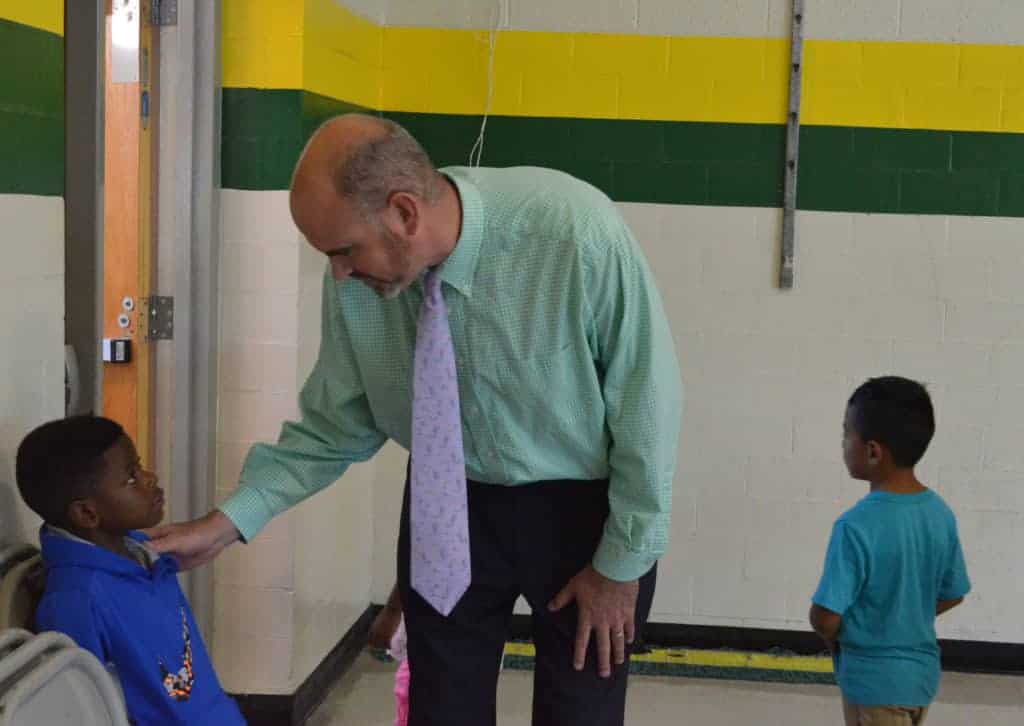
As the role of principals has evolved during the past three decades, so has the research into effective principalship—and the qualities superintendents seek when they hire.
There is little doubt, though, about the need to take great care when selecting a school leader. “School leadership is second only to teaching among school-related factors in its impact on student learning, according to research,” a report from the Wallace Foundation, a national nonprofit that promotes school leadership, asserts. “Moreover, principals strongly shape the conditions for high-quality teaching and are the prime factor in determining whether teachers stay in high-needs schools. High-quality principals, therefore, are vital to the effectiveness of our nation’s public schools, especially those serving children with the fewest advantages in life.”
A 2013 Wallace Foundation report reviewed a decade’s worth of research about school leadership. Five qualities emerged as foundational to a principal’s success:
- They shape a vision of academic success for all students.
- They create a climate hospitable to education.
- They cultivate leadership in others.
- They improve classroom instruction.
- They manage people, data, and processes with the goal of school improvement.
Many of those skills must be learned and yet, as a recent brief by the advocacy group BEST NC (Business for Educational Success and Transformation) articulated, North Carolina has historically done little to equip principal candidates with the knowledge and emotional intelligence necessary to be successful before they assume leadership of a school. Furthermore, professional development opportunities for existing principals have been few in number—or challenging to fit into a busy schedule.
External pressure, such as a focus on accountability through testing, can compound the challenges principals face. Accountability is important, UNC Greensboro associate professor Kimberly Kappler Hewitt says, but a focus on test scores doesn’t always correlate with improvements to student learning. “That pressure has been a real game-changer for school leaders,” she says. “School leaders feel that stress in a particularly acute way.”
Hewitt says the principal needs to be the instructional leader of a school, and far more than just an administrator. The job, she says, requires promoting the growth of teachers, encouraging a guaranteed and viable curriculum is in place and effective, leading instructional improvement across the school, and serving with “an equity lens to make sure the school is working for all students and not just some.”
Nurturing those skills requires a strong pedagogy as a foundation, and regular professional development throughout a principal’s career. “We’ve done some,”says state Rep. Craig Horn (R-Union), who chairs the House committees on K-12 education and education appropriations. “We’re getting better. I believe we have a long way to go. We need to considerably improve our support for the principals on a regular basis.”
But he wrestles with the right way to recruit principals—and the skills necessary to be an effective school leader. He tells a story about a conversation with one educator in North Carolina who made the case that every principal should be an “uber teacher,” that is, one of the best teachers in the district. Horn, who worked as a food broker before running for office, points out that a good salesman does not necessarily make for a good sales manager.
“It seems to me that the skill set you use in the classroom, in conveying the lesson, is not the same skill set you use in administering, running a school,” he says. “I’m not convinced at all that a really good principal needs to be an uber teacher. They definitely need to be a good teacher. But I think the skill set is different. I think the role is different.”
An Imperfect Solution
Although early indications point to the success of programs funded by the Transforming Principal Preparation grant program (TP3) to support high quality principal preparation initiatives, challenges remain for North Carolina’s pipeline of school leaders.
“We need to do a much, much, much better job in identifying the right people, training them and supporting them, and getting behind them—which includes paying them properly,” Horn says.
The legislature last year attempted to address North Carolina’s low national ranking—50th among all states and the District of Columbia—for average principal salary by revamping the way the state calculates principal pay. The previous salary schedule was based upon the number of teachers a principal managed and the size of her school. Under a plan passed in 2017, the state’s new principal salary schedule considers student population size and whether the school met or exceeded growth.
Those are welcome changes, says Shirley Prince, executive director of the North Carolina Principals’ and Assistant Principals’ Association, but they don’t reflect all of principals’ needs. Importantly, they don’t fully reflect the nature of principals’ evolving roles. “It’s astonishing how much fewer resources are being put into schools and how much greater the challenges are,” she says. “The resources have not been commensurate with the public attitude.”
Additionally, she says principals are an important piece of school leadership, but they should be equipped with support staff—assistant principals, counselors, social workers, school resource officers—who are equally essential to creating a safe and successful learning environment. “We are a people business,” Prince says. “It’s all about the talent, and how you support them and train them and compensate them and develop them.
“We have a lot of work to do in that area.”
Since 1993, North Carolina has offered forgivable loans to prospective principals through the Principal Fellows Program, which is offered through a partnership with 11 of 16 UNC system campuses. Much like TP3, it provides a full-time residency component for principal candidates to have “elbow learning” time. But the BEST NC brief acknowledges there are key differences between the programs. “(The Principal Fellows Program) focuses primarily on recruitment rather than program quality, and does not specifically prepare nor require candidates to serve in struggling schools,” the report says. “North Carolina’s leaders will need to continue to assess each program’s outcomes to inform future decisions about investments, alignment, and clarity for principal candidates.”
Even the early success of TP3 is an imperfect solution.
As the BEST NC policy brief outlines, governance of TP3 is cumbersome and involves multiple organizations with varying levels and types of expertise. NCASLD has deep experience with principalship but not in disbursing state funds. It reports to the North Carolina State Education Assistance Authority, which is a quasi-governmental agency tied to the state university system. NCSEAA has expertise in grant programs and state funding but not in principal preparation. The State Board of Education is involved, and so is the General Assembly. “Talented and committed leaders have thus far been able to make this arrangement work,” BEST NC reports, “but all stakeholders will need to continue to assess the governance structure to ensure the success of the TP3 program and its stability for the future.”
Another shortcoming of the TP3 program thus far has been a lack of diversity among the new principal cohorts. While the collective cohorts are more diverse than the current principal population in North Carolina, the breakdown varies significantly by program. Current North Carolina principals are 73 percent white and 60 percent female; the TP3 candidates are 64 percent white and 66 percent female.
But perhaps the greatest challenge is one of scale.
Thus far, TP3 has produced 120 principal candidates—the proverbial drop in the bucket when one considers the 2,500-plus public schools in North Carolina. The North Carolina Alliance for School Leadership Development (NCASLD), the organization that manages the TP3 process, is studying its effectiveness and will report results to the State Board of Education after five years. Leaders are optimistic those learnings will inform future policy decisions about transforming the way North Carolina prepares its public school principals.
Horn says legislators are still trying to understand the best practices for principal preparation—and how those vary in practice among rural and urban school districts. The TP3 transformation and salary schedule overhaul were important steps forward, he says, but challenges remain.
“We have done, I think, some work, in improving principal prep because we’ve at least begun to realize the really critical role of principals and we’ve begun to realize that we have not met their needs,” he says. But that work comes with an acknowledgement that the state and nation have not fully understood the principal’s job, reverting to Hollywood stereotypes or individual misconceptions. “The principal’s office was the terrible place to which you do not want to be sent, “Horn says. “The principal was sort of the king of the roost and they sat in their office and pushed a lot paper, but most of us really didn’t understand what they did.
“We’ve not given principals their due.”

